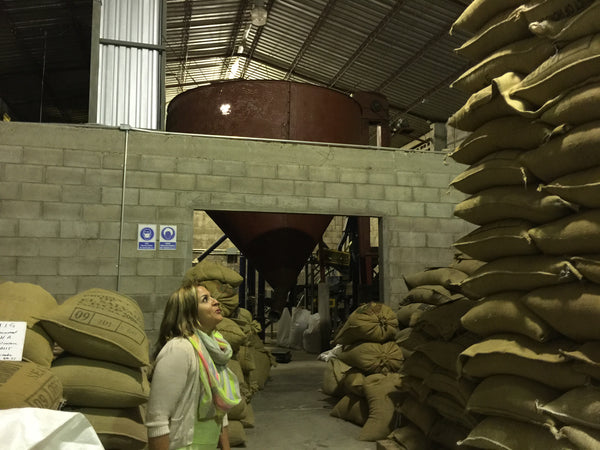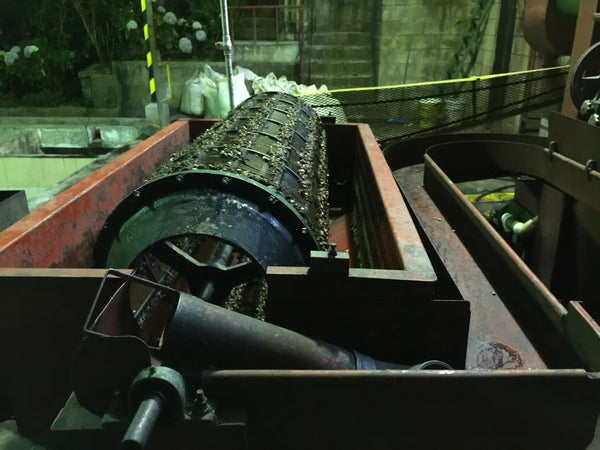This is Part 5 of our Coffee Origin Trip to Central America, follow along on Instagram with #OrigenCA2015. For Parts 1, 2, 3 or 4.
“You haven’t called me in four years,” the tone was emphatic but playful, and I swear it’s only been three years, not four. But arguing a point with a Latin woman is always ill-advised.
Anny Ruth Pimentel observes the bags of pergamino (parchment) coffee stacked to the rafters in the bodega of Beneficio Loma La Gloria.
I first met Anny Ruth Pimentel in 2011 when she was training to be a judge for the fourth Campeonato Salvadoreno de Baristas, the El Salvador Barista Championship in San Salvador where I was head judge. It was the same championship that crowned Alejandro Mendez, who would go on to win the World Barista Championship in Bogota, Colombia later that year. Back then, Anny was doing marketing for a travel company and while she was doing a great job, she was finding that it really wasn’t her calling.
After over a year doing marketing, she approached her father Roberto about starting a coffee shop business. A civil engineer focused on construction and housing development by trade, Don Roberto had grown up in the country and loved everything about farming. Before the Pimentels, the farm was known as Finca Belvedere and owned by Fundacion Knapp, a German NGO. Don Roberto purchased the farm in the late 1990s and decided to rename it after his grandfather’s estate: Loma La Gloria, a place of his childhood glory days.
One of the drying patios at Beneficio Loma La Gloria.
Seeing a future in the coffee business, Don Roberto decided to construct a modern wet mill complete with guardiolas at the farm. However, the 2002 worldwide coffee crisis placed that in jeopardy. With C-Market prices for coffee falling below 39 cents per pound, it was cheaper to leave the newly built mill unused and attempt to salvage what they could. For ten years, this is how Loma La Gloria would operate.
That’s when Anny Ruth decided to get into the family business.
The initial idea was that the coffee shop would serve as an outlet and expression for the coffees of Loma La Gloria, but fearing that his daughter might soon tire of the coffee shop business, Don Roberto nixed the coffee shop idea, so Anny Ruth decided to get into the growing game.
The Criba (evidently, there is no accurate English word) separates the good beans from the bad beans after the hull has been removed.
While she found marketing to be easy and not terribly thrilling, Anny Ruth discovered that her calling was in coffee and with the beans themselves. After an exciting, educational but difficult first year running Loma La Gloria, where she sent her cherries to an independent mill and not receiving quite the exacting results she desired, she decided that Loma La Gloria must operate a mill of their own to achieve the level of quality Anny desired. The biggest problem was convincing Don Roberto.
Enlisting the help of family friends and her father’s trusted advisors to advocate on her behalf, Don Roberto was finally swayed when one of his friends said to him: “You have the horse and your have the saddle, it’s time to let your daughter make it ride.” From there, the wet mill and guardiolas were refurbished, a brand new dry mill was built, and Anny Ruth began her quest for the coffee she had in her mind.
Twin 12,000 kilo guardiolas ready for partial drying of the coffees at Loma La Gloria.
“Coffee Rebel Dynamo” best describes Anny Ruth. At 5’6” in height she’s filled with endless energy and enthusiasm for her coffee, her farm, her people, the betterment of the coffee industry and fostering a new generation of coffee growers. While most coffee farms and mills are run by families with multiple generation legacies, the Pimentels are just getting started with less than 20 years in the business and Anny Ruth just getting rolling. A second-generation coffee grower, with no formal education in coffee agronomy, she has little interest keeping things the same “just because.” That said, Anny (and her experienced farm team) knows the traditional method of doing things but when interested in trying something different, she has little compunction about tossing the textbook aside and giving it a go - which is how her Reposado method of processing came about
It was late in the day by the time we reached Loma La Gloria so we only were able to see just a portion of the farm where Anny Ruth grows 140 manzanas of mostly bourbon. Commenting on the rust disease that has plagued El Salvador for years, Anny Ruth remains committed to maintaining her bourbon crop - that despite her inclination for breaking tradition, there is one thing that she’s like to preserve about El Salvador’s coffee tradition: the Bourbon.
The sorting table waits for final upgrades before the dry milling begins. This table has a moving belt upon which the milled coffee is spread and workers on both sides of the table pick out the less-than-desirable beans for best quality.
Touring around the mill, shadowed (sometimes not so) discreetly by her M-14 armed security guard, we meet some of the farm workers and as we see the wet mill and guardiolas I can’t help but to think about the story of Don Roberto building all of this and then being forced to let it sit dormant for eleven years. On the terraced drying patios the brilliant white concrete tile reminds me of the patios at Cuatro M. Everything at every step of the process at Loma La Gloria is separated and traceable. It’s noteworthy because there are operations that haven’t been able to get to this level of quality and production and Anny’s been able to achieve it in less than three years.
In the bodega, the parchment-covered coffee is stacked nearly to the rafters. Anny Ruth expects to ship at least four containers this season - a record high for Loma La Gloria. For me, one of the most interesting things to see at Loma La Gloria is their dry mill. Installed just a couple of years ago during the mill renovation (Don Roberto had never bought a dry mill back then), it’s practically new and I’m fascinated to see what modern-day ollivers and density sorters look like and how the designs have evolved.

For the most part, Loma La Gloria is like most coffee mills: functional and industrial. That is, until you get to the cupping room where it is decidedly homey, comfy and feminine. Colored glass tile serves as a splash guard above the natural wood counters, the brick walls are painted a faint cream color, an old school grocery store red Grindmaster grinder sits in the corner and framed pictures of Anny Ruth, her niece and family line the walls. It’s a striking difference from the masculine dominated world of coffee that’s either very industrial, or cupping rooms of timber and steel. For the most part, her male dominated farm team has gone along with working in such a homey environment but when Anny Ruth put light colored curtains on the windows, the farm manager finally had to say something - yet they still remain today.
As our tour of Loma La Gloria ended, I was left with the impression that this dynamo of fire and passion for coffee, and seeing the incredibly vivid samples, might just be the rebel that changes the industry.
Green coffee samples looking absolutely stellar with some of the most attractive packaging I've ever seen from Anny Ruth and Finca Loma La Gloria.





